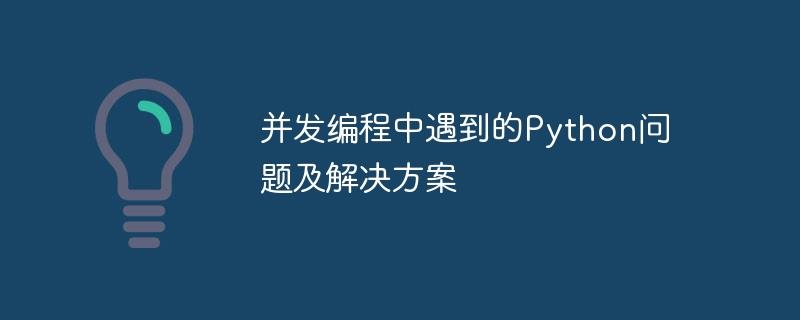
标题:并发编程中遇到的Python问题及解决方案
引言:
在现代计算机系统中,利用并发编程可以充分发挥多核处理器的性能,提高程序的运行效率。Python作为一种广泛使用的编程语言,也具备了强大的并发编程能力。然而,并发编程中常常会遇到一些问题,本文将介绍一些并发编程中常见的Python问题,并提供相应的解决方案,并附有具体的代码示例。
一、全局解释器锁(GIL)
- 问题概述:
在Python中,全局解释器锁(Global Interpreter Lock,简称GIL)是一种对多线程运行的Python程序的限制。GIL导致在多核处理器上并发程序无法真正并行执行,从而影响了Python并发程序的性能。 - 解决方案:
(1)使用多进程代替多线程,在多个进程之间实现真正的并行执行。
(2)使用Cython等工具,通过编写C扩展模块来绕过GIL的限制。
示例代码:
import multiprocessing
def compute(num):
result = num * 2
return result
if __name__ == '__main__':
pool = multiprocessing.Pool()
numbers = [1, 2, 3, 4, 5]
results = pool.map(compute, numbers)
print(results)登录后复制
二、线程安全性
- 问题概述:
多线程环境下,多个线程同时访问共享资源时可能会引发数据竞争(data race)等线程安全问题,导致程序出错。 - 解决方案:
(1)使用互斥锁(Mutex)来确保同一时间只有一个线程能够访问共享资源。
(2)使用线程安全的数据结构,如threading模块中的Queue队列。
示例代码:
import threading
import time
class Counter:
def __init__(self):
self.value = 0
self.lock = threading.Lock()
def increment(self):
with self.lock:
old_value = self.value
time.sleep(1) # 模拟耗时操作
self.value = old_value + 1
if __name__ == '__main__':
counter = Counter()
threads = []
for _ in range(5):
t = threading.Thread(target=counter.increment)
threads.append(t)
t.start()
for t in threads:
t.join()
print(counter.value)登录后复制
三、并发数据共享
- 问题概述:
在多线程或多进程程序中,数据的共享是非常常见的需求,但同时也带来了数据一致性和竞争条件(race condition)等问题。 - 解决方案:
(1)使用线程安全的数据结构,如threading模块中的Queue队列来协调不同线程/进程之间的数据共享。
(2)使用进程间通信(Inter-process Communication,IPC)机制,如队列、管道等。
示例代码:
import multiprocessing
def consumer(queue):
while True:
item = queue.get()
if item == 'end':
break
print(f'consume {item}')
def producer(queue):
for i in range(5):
print(f'produce {i}')
queue.put(i)
queue.put('end')
if __name__ == '__main__':
queue = multiprocessing.Queue()
p1 = multiprocessing.Process(target=consumer, args=(queue,))
p2 = multiprocessing.Process(target=producer, args=(queue,))
p1.start()
p2.start()
p1.join()
p2.join()登录后复制
结论:
本文通过对并发编程中常见的Python问题进行分析,提供了相应的解决方案,并附有具体的代码示例。并发编程是提高程序运行效率的重要手段,合理解决并发编程中的问题,将会大大提高程序的并发能力和性能。
